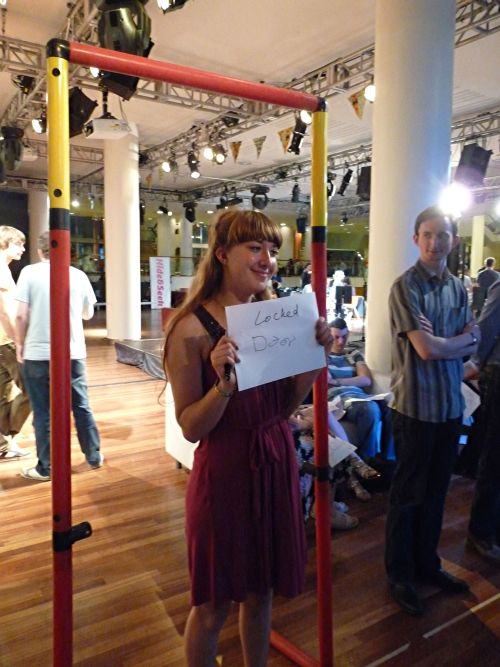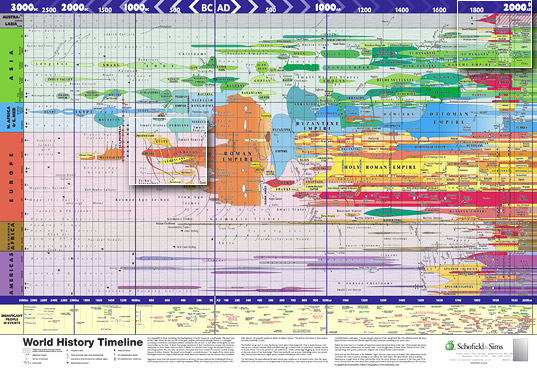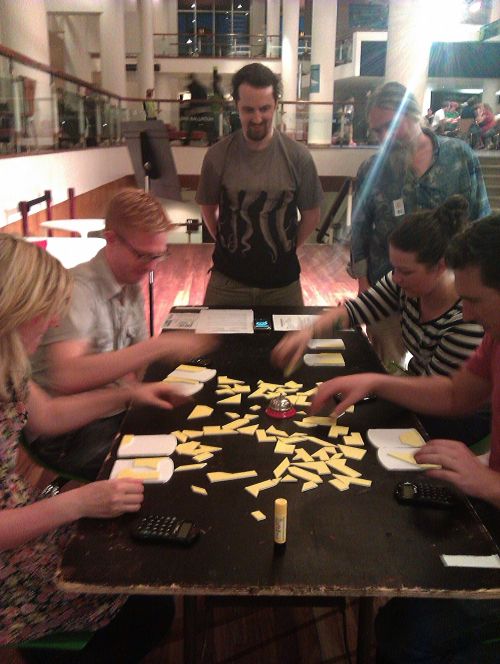(Originally sent May 2009)
Film
I saw Wolverine. I found it to be acceptable. I was particularly impressed that they held almost all shots of the enjoyably over-the-top climactic battle back from the trailer.
Video
In this video there are giant flying robot penguins, after the small swimming robot penguins, after the pre-roll ad, after the video loads. But worth the wait.
Link
Since the media make it very difficult to tell if a manageable disease outbreak has grown into a rampant society-threatening pandemic of doom, here’s a map that collects data on the progress of Swine Flue cases.
Semiotically speaking, the size of the circles when zoomed out subconsciously suggests a more severe situation than is actually the case, but zooming in quickly brings things into perspective.
Quotes
Going through my old archive of things-I-heard-people-say-and-wrote-down recently, I found a cluster of baffling utterances all made by the same individual, who shall remain nickless. Er, I mean nameless.
“I’ll take your word for it – but I’m still not convinced.”
“Is it one of those things you can only see when you look at it?”
“I don’t like shopping, it’s really boring. Except when you’re buying something for yourself… or someone else.”
Picture
I’ve come across this three times this week, but feel compelled to add to its viral propagation. Here and There is a “horizonless projection” map of Manhattan, which some have more intuitively described as a “hamster wheel projection”.
Previous Puzzle – The Inconvenient Hobby
Last time I asked for a time-based goal that can easily become part of a routine but sits somewhere between once-a-day and once-a-week. Given some of the answers, it became clear I hadn’t emphasised the ‘easy’ part sufficiently!
One answer was to tie different aspects of the same goal to different days of the week For example, if the goal is to exercise 3 times a week then one could do three activities once a week each, assigning each one to a particular day of the week.
My own answer has been to create a spreadsheet which automatically pops up when I boot up my PC and tells me how many days have elapsed since I last did the six things I’m trying to do with non-trivial frequencies, and whether that exceeds my target number of days to elapse for each one. Or at least, that will be my solution, but I haven’t got around to implementing it yet, which perhaps speaks to a greater problem.
Puzzle – the Space Stick
Information cannot travel faster than the speed of light. If it did, you just need to apply a bit of special relativity (not even general relativity) and you quickly get paradoxes. There’s a deeper argument to be made there, but trust me, if information could travel faster than the speed of light, It Would Be Bad, in the Ghostbustersian sense.
(Side note: that link was an example of something Kevin Kelly has spoken about – bringing the tools we have for literacy (cut and paste, footnoting, referencing) to moving pictures. Unfortunately the audio is very quiet on the YouTube video I linked to so it probably doesn’t quite work, but it’s close. See http://kk.org/ct2/2008/06/tools-for-vizuality.php )
[We now see further problems interfering as the video has been taken down. It linked to the utterance of the phrase “that would be bad” in Ghostbusters. – T.M. 30/4/11]
Unfortunately this important speed limit on information transfer seems to break if you have an extremely long stick.
It’s difficult to state the problem both precisely and concisely, but here we go:
Imagine you are at one point in space and your friend is one light-year away. You are about to have a baby and your friend will want to know if it is a boy or a girl as soon as possible. If you were to send this message at the speed of light, which is incredibly fast, it would still take one year for the message to reach them, since you are one light-year apart.
Anticipating this issue, you have got hold of a Space Stick, which is one light-year long and as rigid and low-mass as a substance can possibly be. With the Space Stick spanning the distance between you and your friend, you arrange for it to sit above a button that activates a buzzer at their end, the idea being that you simply press on your end of the Space Stick and the button is pressed pretty much instantaneously.
With a pre-arranged code (tap for a boy, long press for a girl) it seems as if this could be used to transmit information faster than light. Why could it never work?
Things 47
Film
I saw Wolverine. I found it to be acceptable. I was particularly impressed that they held almost all shots of the enjoyably over-the-top climactic battle back from the trailer.
Video
In this video there are giant flying robot penguins, after the small swimming robot penguins, after the pre-roll ad, after the video loads. But worth the wait.
http://www.newscientist.com/article/dn16996-bionic-penguins-take-to-the-water–and-the-skies.html
Link
Since the media make it very difficult to tell if a manageable disease outbreak has grown into a rampant society-threatening pandemic of doom, here’s a map that collects data on the progress of Swine Flue cases:
http://flutracker.rhizalabs.com/
Semiotically speaking, the size of the circles when zoomed out subconsciously suggests a more severe situation than is actually the case, but zooming in quickly brings things into perspective.
Quotes
Going through my old archive of things-I-heard-people-say-and-wrote-down recently, I found a cluster of baffling utterances all made by the same individual, who shall remain nickless. Er, I mean nameless.
“I’ll take your word for it – but I’m still not convinced.”
“Is it one of those things you can only see when you look at it?”
“I don’t like shopping, it’s really boring. Except when you’re buying something for yourself… or someone else.”
Picture
I’ve come across this three times this week, but feel compelled to add to its viral propagation. Here and There is a “horizonless projection” map of Manhattan, which some have more intuitively described as a “hamster wheel projection”:
http://schulzeandwebb.com/hat/
Previous Puzzle – The Inconvenient Hobby
Last time I asked for a time-based goal that can easily become part of a routine but sits somewhere between once-a-day and once-a-week. Given some of the answers, it became clear I hadn’t emphasised the ‘easy’ part sufficiently!
One answer was to tie different aspects of the same goal to different days of the week For example, if the goal is to exercise 3 times a week then one could do three activities once a week each, assigning each one to a particular day of the week.
My own answer has been to create a spreadsheet which automatically pops up when I boot up my PC and tells me how many days have elapsed since I last did the six things I’m trying to do with non-trivial frequencies, and whether that exceeds my target number of days to elapse for each one. Or at least, that will be my solution, but I haven’t got around to implementing it yet, which perhaps speaks to a greater problem.
Puzzle – the Space Stick
Information cannot travel faster than the speed of light. If it did, you just need to apply a bit of special relativity (not even general relativity) and you quickly get paradoxes. There’s a deeper argument to be made there, but trust me, if information could travel faster than the speed of light, It Would Be Bad, in the Ghostbustersian sense.
[Side note: that link was an example of something Kevin Kelly has spoken about – bringing the tools we have for literacy (cut and paste, footnoting, referencing) to moving pictures. Unfortunately the audio is very quiet on the YouTube video I linked to so it probably doesn’t quite work, but it’s close. See http://kk.org/ct2/2008/06/tools-for-vizuality.php ]
Unfortunately this important speed limit on information transfer seems to break if you have an extremely long stick.
It’s difficult to state the problem both precisely and concisely, but here we go:
Imagine you are at one point in space and your friend is one light-year away. You are about to have a baby and your friend will want to know if it is a boy or a girl as soon as possible. If you were to send this message at the speed of light, which is incredibly fast, it would still take one year for the message to reach them, since you are one light-year apart.
Anticipating this issue, you have got hold of a Space Stick, which is one light-year long and as rigid and low-mass as a substance can possibly be. With the Space Stick spanning the distance between you and your friend, you arrange for it to sit above a button that activates a buzzer at their end, the idea being that you simply press on your end of the Space Stick and the button is pressed pretty much instantaneously.
With a pre-arranged code (tap for a boy, long press for a girl) it seems as if this could be used to transmit information faster than light. Why could it never work?








